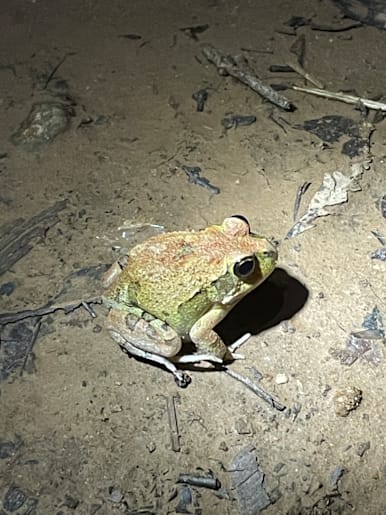
Eastern grey kangaroos are losing their habitat across Ipswich.

Koalas are losing their habitat across Ipswich.

Reptiles such as this ornate burrowing frog are being made extinct locally.
TWO keystone environmental reports aimed at increasing ecological sustainability in the city received unanimous approval in the council chambers recently.
The Urban Greening Plan 2022-2042 and the Sustainability Strategy 2021 to 2026 are council bids to bring an “informed and evidence-based direction in achieving increased vegetation cover in priority areas within the urban footprint of Ipswich to best achieve the multiple benefits it can provide”.
The Sustainability Strategy talks up council efforts that include rooftop solar and “decarbonisation”.
Urban Greening in Ipswich sets targets of a minimum 50 percent of new landscape plantings to be local native species and the planting of 860 trees over two years to offer streets more shade.
However, University of Queensland biologist and scientist Dr Christina N. Zdenek said the urban greening project was too feeble to have any real effect.
“A target of 50 percent native species landscape plantings would be laughable if it were not so depressing and worrisome,” Dr Zdenek said.
“How on earth is it that new landscape native species plantings are not 100 percent? I can’t understand this. In the least, it should be 75 percent or 90 percent.
“And where is mention of threatened species like koala, powerful owl, platypus in plantings, creek bank stabilisation, and sediment runoff from developments into creeks creating sand slugs that destroy habitat needed for native threatened fish and platypus?
“We already have locally native plants existing at many native nurseries in the region that cover all soil, sun, drainage, size, habit, safety etc aspects that could be required in their plantings.
“The council must try harder and do better; 50 percent is a very poor target for this and the planting of 860 trees is insufficient in achieving increased vegetation cover – 860 is a random and very small number.
“Other jurisdictions like the Scenic Rim have the One Million Trees initiative with a goal to increase urban greening and decrease heat-island effects.
“Council mentions the planting of trees at the 50m mark but this is too sparse to provide connected shade for pedestrians and exercisers.
“Bus stops should have extra trees, not zero trees like they currently do in new suburbs like Whiterock."
She said the mention of only four community plantings a year was inadequate.
“These plantings should be monthly,” Dr Zdenek said.
“At the very least six, so 50 percent more than what their target is.
“A brilliant way to increasing total canopy cover of this council by 2042 would be not to clear the 420 hectares of Woogaroo Forest – that’s an obvious one.
“Otherwise, this is literally multiple human generations of waiting time for any new plantings to have anywhere near the canopy cover of what already exists in that forest.
“The bird industry in Australia is worth $2.6 billion annually.
“Southeast Queensland is a birding hotspot, with 504 species recorded here out of the 684 total for Queensland (compared to around 700 species on all of mainland Australia).
“So if the Ipswich City Council was smart economically, they would promote Woogaroo Forest as a birding hotspot and package it up as a tourist hotspot, rather than bulldoze it and cause more traffic jams on the Centenary Highway.
“To mitigate impacts of developments, two major things need to happen: development plans need to incorporate old-growth trees into their plans (could be a wonderful feature for any new development-established trees bring dollars and tourists … think of Noosa) and build around them.
“A certain number of trees per hectare should be required to be kept on site because it’s often two human generations need to pass before you can get such trees again.
“Linear wildlife corridors need to be incorporated into developments.
“There are several species that will never cross over a certain distance (50m for Fairy Wrens) of cleared land or lawn without cover to rest and escape predators and bully birds like Noisy Miners that are favoured by ‘lawn and tree’ landscapes.
“Just look at the new development across from Whiterock … scorched-earth style development.
“Not a single tree or shrub or blade of grass left for 500-plus metres squared. A massive area. Not even the drainage line was kept.
“This council must stipulate that in its permits.”
Dr Zdenek said the problem of weeds was mentioned only five times and in just one context.
“And where is the pressure from this council on developers who own big land that don’t manage weeds such as at Bellbird Park and are not held accountable for even maintaining category 3 level weeds such as cat’s claw, a canopy killer that is slowly killing the old eucalypts at Eugene Street forest within Woogaroo?” she asked.
“I have told council several times about an internationally significant weed called pampas grass getting out of control along the Centenary and at developments like Whiterock.”
Former Queensland Chief Scientist Professor Hugh Possingham agreed.
“This council has no idea if things are getting better or worse,” Professor Possingham said.
“The whole city is cheaply monitored using Birdlife 20-minute 2 hectare counts which provides a baseline set of data to monitor change and is the cheapest way for them to track change.
“Without such cheap citizen science monitoring, the council is flying blind.
“I have told them how to do this and offered to help.”





